|
Vowels are indicated by dots, dashes and small signs
placed in various positions against the sides of the strokes, and
sometimes joined to strokes. The shape, thickness and position
against the stroke are all meaningful pieces of information that
identify which vowel is meant, i.e. you cannot vary these. Some
angles may be varied, some not. Joining to a
stroke is not meaningful, just convenient.
They represent the spoken sound and not
the longhand written form. Some short forms use just a vowel sign on
its own for certain short words (see
2nd half of
List4 for short forms derived from vowel signs).
They do not follow exactly the
variations in vowel sounds spoken by different regional accents, or
even variations within the same accent.
Shorthand textbooks and dictionaries follow what is termed
Standard English/Queen's English/BBC English/Oxford English/Received Pronunciation
which approximates to English spoken in the mid-to-south of the UK.
Examples given here will adhere to that and you should make
adjustments to suit your own situation.
Substituting other vowels to accommodate your own
variety of English does seem reasonable and not likely to
cause problems if done thoughtfully and sparingly,
bearing in mind that you may be taking dictation from speakers with
a variety of accents. This may result in a change of outline
position, as you will not generally be writing in all the vowels. It
may also throw up a new set of clashing outlines, different from
those listed on the Distinguishing Outlines page. You should keep notes of your variations
and be totally consistent in their use. It does not seem advisable
to attempt learn the system and revise it all at the same time!
If
your shorthand becomes highly personalised as regards pronunciation,
you will create difficulties for yourself when the speaker does not
sound like you. At the lower examination speeds you may be marked on
your shorthand outlines, so caution is needed, and if you wished to
teach Pitman's Shorthand, then you cannot deviate from the vowel
values and signs given in the textbooks and dictionaries.
When taking from dictation, you are not expected to reflect the
speaker's accent which may vary from your own. If you had to read it
back to the speaker, it would be insulting if you read it in his/her
accent! If you came across a
dialect word for the first time, you would of course write it
exactly as
pronounced, as you would have nothing else to compare it with.
On this page I have written in all the vowels,
although you will not do this during normal note-taking.
Quick reference table
Short and Long vowels
Diphthongs
Diphones
Triphones
Vowel placement
Intervening vowels
Position writing
Omission of vowel signs
QUICK
REFERENCE TABLE
| Name & Place |
Examples |
Additional
vowel |
Mnemonic |
| SHORT VOWEL |
|
Vowel plus one = diphone |
|
| 1 |
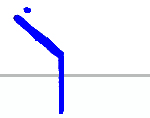 bat
bat |
 sahib
sahib |
THAT |
| 2 |
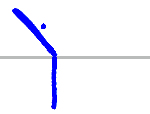 bet
bet |
|
PEN |
| 3 |
 bit
bit |
|
IS |
| 1 |
 tock
tock |
|
NOT |
| 2 |
 tuck
tuck |
|
MUCH |
| 3 |
 took
took |
|
GOOD |
| LONG VOWEL |
|
|
|
| 1 |
 pa
pa |
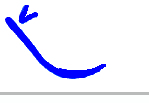 baa-ing
baa-ing |
PA |
| 2 |
 pay
pay |
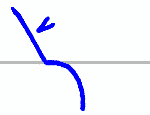 payer
payer |
MAY |
| 3 |
 pea
pea |
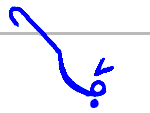 previous
previous |
WE |
| 1 |
 saw
saw |
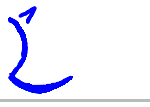 sawing
sawing |
ALL |
| 2 |
 so
so |
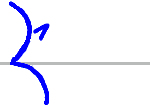 sower
sower |
GO |
| 3 |
 sue
sue |
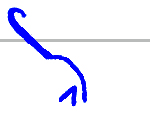 bluer
bluer |
TOO |
| DIPHTHONG |
|
Diphthong plus one = triphone |
|
| 1 |
 by
by |
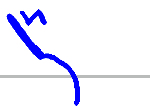 buyer
buyer |
I |
| 1 |
 boy
boy |
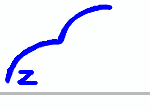 loyal
loyal |
ENJOY |
| 3 |
 out
out |
 power
power |
LOUD |
| 3 |
 few
few |
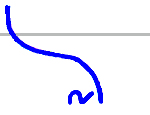 fewer fewer |
MUSIC |
Top of page
SHORT AND LONG VOWELS
Short vowels = light dot or dash
Mnemonic: THAT PEN IS NOT MUCH GOOD
Long vowels = heavy dot or dash
Mnemonic: PA MAY WE ALL GO TOO
The mnemonics contain short forms so those particular outlines cannot be
used to illustrate all the vowels, but the simplicity of the
sentences has served generations of shorthanders very well over the years and they are worth
preserving as our "shorthand heritage".
The dashes are written at 90° to straight strokes,
therefore they change their angle as the stroke changes its angle.
The dash is generally written from the stroke outwards and about a
quarter of the length of a normal stroke; a dash should not be
written straight up or straight backwards, in order to maintain
smooth writing and avoiding catching the nib against the paper. Against horizontal strokes
the dash is always written downwards. For curved strokes, the angle of 90° changes along the length of the stroke.
The angle of a dash vowel is therefore not meaningful when used in
an outline, but is only meaningful when used alone as a short form –
See Short Forms List 4 page
Short forms
from vowel marks:

toe gnaw know noose maw mow moon
bought
Some dash vowels end up being written with an
upward slant and this is the only time that any thick mark is
written upwards, as in the outline "bought" above. The angle of the dash may be adjusted slightly in
places where there is limited room between strokes:

droll dhurrie roach
Heavy dots and dashes must be written with one
stroke of the pen, not moved around on to thicken them up.
Students of phonetics will notice that in Queen's
English "pay" "sew" and similar words are not simple vowels but diphthongs,
despite all the shorthand books describing them otherwise. They and the
diphthongs below are, however, single phonemes (meaningful units of
sound) in English, and generally found within one syllable, which is why they are perceived as one sound. I
suspect that such words are pronounced with simple vowels in English accents
other than the present Queen's English standard. This is borne out
by a teachers' textbook that I have which advises south of England
teachers to place extra emphasis on the "pure long vowel" of "lake",
which to southern English ears does sound more like an accent from
further north of the country.
Top of page
DIPHTHONGS (pronounced
dif-thong
**note** )
Two vowels sounded in quick succession, glided together and
producing one syllable.
Mnemonic: I ENJOY LOUD MUSIC
-
There are 4 diphthong
signs - two first place, two
third place.
-
There are no second place diphthong
signs.
-
No heavy versions.
- The first three
never change angle, the last may be rotated when joined.
First place

pie tie china lie rye my nice

fine vie thigh sigh shy sky wise high
I/eye
Joined at the beginning of
some downstrokes
and in phrases:

ice eyes idea item Ivan ire, I have, I think, I say, I
shall
For convenience, joined finally to stroke En
(despite being a first place vowel) when no other
stroke or ending follows:

night nigh deny downright fortnight finite Anno Domini but nights denies
Contracted to a tick on
upward Ell:

isle/aisle island islander
Eileen/Aileen (but Aileen
if so pronounced)
As short form for "I",
contracted in phrases where convenient:

I believe, I propose, I regret, I can, I am, I
will have
First place
The top half of the sign is written horizontally:

poise toy joy coy
coil moist noise foible voice hoist
Joined only to upward Ell. The angle is adjusted
slightly but this does not clash with the third place vowel "owl"
because of the outline's position. Not
joined to other strokes because not convenient and could be confused with "of the":

oil oiled oil-field oil-tanker oil-well
Third place

out ouch joust cow mouth
noun found shout loud how (short form) Joined initially
to upward Ell, despite being a third place vowel, for convenience:

owl owlet owlish owl-like
Joined as short form
in phrases:

how many, how long
Joined finally where
convenient:

bow prow pout brow browed dhow/Dow doubt vow thou
sow Howe
Contracted after stroke N, when nothing else follows in
the outline:

now Lucknow but nous
Third place

puma tune tuna tube cube suitable fume music Hume you
(short form)
(the surname "Hume" is sometimes pronounced "home")
Joined finally where
convenient, when nothing else follows in the outline. Rotated
when joined finally to horizontal strokes or upward ell. Do
not rotate when free-standing, because this clashes with the
W series of signs:

few pew cue/queue/Kew due/dew mew new continue pursue value
As short form, joined where convenient:

thank you, if you will, for you are, you should, can you,
may you
Top of page
DIPHONES
A simple vowel followed immediately by another separately
sounded vowel, thus forming 2 syllables.
Arrowhead, at 45° angle pointing south west, is
used for a dot vowel plus any other:

sayer layer weighing previous readmit create neon
tiara Maria
Arrowhead, at 45° angle pointing north east, is used for a dash
vowel plus any other:

sower snowy stoic poem gooey bluey jawing gnawing
rawish
Diphones are often encountered as extensions to an original
simple vowel, and so the vowels are perceived as two
separate phonemes (meaningful units of sound):

pay payer mow mowing mower high
higher
but hire
Also used for
these types of endings, although the vowels are barely sounded separately:

righteous question suggestion
combustion pinion onion bunion but Bunyan

trachea* tracheae*
Separate dots are used for the plural to distinguish
the outlines - the extra dot cannot be mistaken for Dot Hay, because
Dot Hay is never used finally.
*pronounced track-ee-uh and track-ee-ee
Diphones are not used for:
(a) short forms that have stroke Ing added,
because short forms are not vocalised, and the Ing needs only its own dot:

be being go going do doing
(b) when adding "dot ing" because the
dot represents the whole "ing" extension:

paying toying trying
but tryingly
Top of page
TRIPHONES
Three vowels sounded in succession, normally a
diphthong plus one other, producing two syllables. Shown by
extending the diphthong sign with a tick.

diary dial briar trier diameter flyer
denying ionise

loyal royal joyous soya boyish
moiety annoyance sequoia

power tower flower/flour towel vowel

viewer duet continuous puerile
steward skua skewer but secure
Some triphones consist of a simple vowel followed
by a diphthong: write the diphthong next to the vowel (note the
light dot is used):

radii genii denarii nuclei
As with "tracheae" above,
the dot cannot be mistaken for Dot Hay, because Dot Hay is never
used finally
Top of page
VOWEL PLACEMENT
1. A vowel sign is placed to the side of the stroke, at the
beginning, middle or end. The vowels are therefore described as first,
second and third place vowels.
-
All the strokes of the outline or phrase must be
completed before any
unjoined vowel is written.
-
The beginning of a stroke is counted from where
the pen starts writing it. With strokes that can be written in
either direction, the vowel placement will vary, and care should be taken
when the stroke stands alone, both in writing and in transcription.
-
Vowel before: place to left of up or
downstrokes, upper side of horizontal strokes
- Vowel after: place to right of up or downstrokes,
lower side of horizontal strokes

ape pay, Abe bay, aid day, age jay, ache Kay

aim may, inn no, ingle swinger

if fee, Eve vie, either thought,
thin

us so, owes zoo, ash show

ale low, air row, awake way, ayah yes, ahem high
2. Place outside of
circle S, Sway, Stee and Ster loop:

bees beast swan star stock stopper
poster blister
3. SES circle is deemed to include the vowel in
"pen"; if it is a different vowel, write it inside the circle:

success masses
bases (plural of base), basis, bases
(pronounced baseez,
plural of basis)
emphasise emphasis exercise
Dash vowel inside the circle – Books vary in
showing at what angle it is written:

census Colossus exhaust
4. Shun hook – vocalise the stroke just as
you would if the shun hook were not there, with the following
exceptions:
(a) Third place dots written inside the shun hook:

fashion fission vision revision mission
permission lesion
In most cases the dot inside the hook is the vowel immediately
before the Shun, but sometimes it is the vowel before that:

remission
television
compare initiation
(b) Third place dashes, diphones and diphthongs
are written
outside the shun hook when the hook is final (because they need more room) and
inside when the hook is medial (to avoid the sign being read as belonging to the
next stroke).

fusion solution ammunition revolution
revolutionary education educational

radiation mediation
pronunciation renunciation deviation deviationist
The vowel between the Sh and N of the "shun" is
not vocalised at all, and the fact of the vowel being written inside
or outside the hook is coincidental to getting the dot or dash
or other sign against its own stroke, i.e. it is not part of the "shun" syllable.
Circle S + Small shun hook – the hook is deemed to
include the vowel in "much" and requires no vocalisation itself. The
vowel that comes between circle S and the small shun hook:
- Dash vowel: never occurs
- First place dot: never occurs
- Second place dot: omit
- Third place dot: write outside the hook
(underlined below)

possession position precision
decision condensation physician
incision
sensation musician recession recision
In these examples underlined above, the vowel sign
is actually being written against the little hook and not against
the stroke, i.e. it is sounded after the S and before hook, and not
sounded before the stroke. A third place vowel before the stroke
should be placed a little way inwards from the hook. The following
illustrates two vowels on the hook side of stroke:

apposition opposition imposition
5. Ell is normally an upstroke, therefore:

ell ill ale eel isle oil owl*
Eli Leah
*In "owl" the third place vowel is
joined to the beginning of the stroke for convenience, the only word
that does this.
When Ell is written downwards, the vowels follow
suit:

like alike
6. Ish is normally a downstroke, therefore:

ash shy shah shot show shut she
shoe/shoo shoot/chute sheet shout
When Ish is written upwards the vowels follow
suit:

shaggy shagreen/chagrin, shack
shackle, sham shammer
7. After a halved
stroke, the vowel should
be written against the second stroke, as it is sounded after the T
or D:

cottage pottage bandage octopus
potato written
8. All dots and dashes
should be just far enough away to be distinguishable as separate
marks, so that they do not interfere with the recognition of the
strokes themselves. Only these instances have a dash vowel
joined:

awl also;
the short form "all" may also be joined as in: almost already
Top of page
INTERVENING VOWELS
Intervening means "coming between"
(A) coming between two strokes
1st and 2nd place vowels: place against the
preceding stroke:

pod paid bat boat dock duck tag
take jag jug

mock make notch nape shadow shed
lock lake

rag rug wad wed yak yoke
hack hake hang hung
3rd place vowel: place before the following stroke. This is because a third place vowel written after
the first stroke could end up in an
angle between strokes and therefore be ambiguous – you would not know
whether it was a third place vowel after the first stroke, or a first
place vowel against the next stroke:

peel pull big beet book tick took

deep jig cheap fig food video meal nil

pip peep bib beep cook gig
If the two strokes are separated by a circle S or
S-plus-hook, then the vowel must remain with the
first stroke, it cannot "jump" over the S, because it is
sounded before. The presence of the S or S-plus-hook enables the vowel to
be written in its correct third place with less ambiguity:

Dick disk, lip lisp, creep crisp, ping pinning
A compound word is one that is made up of two
other words. In the outline for a compound word, the vowel often remains where it
would be if the words were written separately, thus aiding
legibility:

headache book-end steam-engine
Compound words are treated as one outline as
regards to position (unlike phrases where the first word is written
in position and the others tag along). Therefore the first up or
down stroke might reside in the second of the two words, such as
"steam-engine" above.
The above does not apply to derivative words,
where there is one word and one affix; these have the vowels placed
normally according to the basic rules:

unable inorganic inactive fewness
steamer
(B) coming between an initial hook and the
stroke (e.g. PR and PL)
See also
Theory 7 Hooks R L/Vocalisation and
Theory 15 R
Forms page/R Hook For Brevity for more examples.
Although the R and L hooks are primarily used to
represent the two consonants together, sometimes the hooked form is
used even though a vowel is present, in order to avoid an awkward
outline or obtain a better outline for very common words. Most of
such intervening vowels are only lightly or indistinctly sounded.
If the vowel is "-er" as in "permit" it is not
shown. It is however taken to be a second place light dot vowel (and
is in fact shown as such in other outlines that are not using a
hook) and so the outline takes second position, where this is
the first vowel.

person permit perfect pearl girl
term germ thermal
A dot vowel is written as a disjoined circle, in
its correct place, generally after the stroke, unless that place is occupied by
another vowel or there is no room to write the vowel.

challenge sharp
carbon philosophy varnish flashily atmosphere atmospheric
Note: Very many "car+consonant" words use the R
hook

questionnaire debonair concessionaire
legionnaire doctrinaire doctrinaire*
*Optional contraction

disciplinarian veterinarian
centenarian octogenarian*
* Thus in the dictionary, and all the
"-genarian" words, with circle before the N stroke
A dash vowel is written across the beginning of
the stroke, through the centre or through the end; it is not written
across the end because that would look like the "ings" suffix.
Where a second place dash vowel is written through the
stroke, the following vowel has to be written against the next
stroke, as in "courage" and
"occurrence" below:

tolerable correspondence
church George shovelful fulfil courage occurrence
A diphone or diphthong may also be written through,
or at the end of, a hooked stroke:

healthier junior loftier direct
(2 pronunciations)

temperature mixture capture captures
capturing
The above use of R or L hook plus intervening
vowel is not generally used for words of one syllable:

pale pair tall tore jeer mare
Some short words use the intervening vowel to gain
a brief outline, where clashes are unlikely:

nurse dark
gnarl barm course turkey
NOTE: The prefixes "self-" and "self-con-"
also use a circle (in this case representing the S sound), and the
outline is always in second position to match the vowel in "self".
-
"Self-" circle is
written before the stroke in second position. It might therefore look identical to a 2nd position intervening vowel,
but the rules state that the short E vowel between stroke and
hook is not shown (whether accented or not), although all other
vowels may be shown. Therefore no clash occurs.

self-defence self-employed, Jersey shelf
(2nd position vowel not written)
-
"Self-con-" circle
is written against the top end of the stroke, replacing the
"con-" dot, so this cannot be mistaken for an intervening vowel,
which is always against the side of a stroke.

self-confidence self-control
"self-" and "self-con-" must always be
written, unlike the vowels which are only written when needed (see
Theory 18 Prefixes page).
POSITION WRITING
Position writing is a
great strength of the system, enabling vowels to be indicated without any extra writing.
Position writing combined with the various choices of abbreviating
methods combine to make it clear which word is signified, without
guesswork, when the vowels are eventually omitted. Unlike omitting
vowels, position writing is not optional and you should practise
inserting vowels until you know their placement perfectly, for two
reasons: you need to know what and where they go in order to write
the outline in the correct position, and when you do need to insert
them, you have to do it very rapidly.
The first up or downstroke of the outline is placed in one
of three positions in relation to the ruled line of the page, to
match the place of the first vowel sound of the outline:
First position:
ABOVE the line |
 |
PA |
ALL |
THAT |
NOT |
I
ENJOY |
Second position:
ON the line |
 |
MAY |
GO |
PEN |
MUCH |
|
Third position:
THROUGH the line |
 |
WE |
TOO |
IS |
GOOD |
LOUD
MUSIC |
Note: the vowel in the prefix dot "con-" is ignored when deciding on the first vowel sound of the outline.
As there is such a large
number of con- & com- words, a means of vowel indication through
position writing has to be maintained. Words beginning with the
disjoined circle for "self-" or "self-con-" are always written in
second position, to accord with the vowel in the word "self".
As the second and subsequent up or downstrokes in
the outline simply follow on from the first one, their position with
regard to the ruled line carries no meaning. An outline that is
written as part of a phrase may end up out of position and may need
a vowel inserted to keep it readable.
If the first up or downstroke is a doubled one,
then the first half of it is placed in position:

father curvature alter latter
letter litter
"Father" should be started at high up as possible,
and the end of the stroke will probably run through the ruled line,
unless your shorthand writing is very small. With "latter" the end
of the stroke may invade the ruled line above, but this is
acceptable. You should not reduce the full double length in order to
squeeze it within the ruled lines. You need the full length for
clarity, so aim for longer rather than shorter. Inserting the vowel
helps when there is only one stroke – the vowels are placed further
apart on doubled strokes.
Only a full up or downstroke can be written through the line, so
if the first up or downstroke is halved, or there are only
horizontal strokes in the outline, third position is also ON the
line, sharing it with second position.
Although horizontal strokes and halved
up or downstrokes have no third position, vowels still have a third place against the stroke.
For halved strokes, the three places are closer to each other along
the shorter length:

fat fate fit

pit bed jade Mick moon noon cook
Note:
Vowels have a PLACE against a stroke
Outlines have a POSITION in relation to the ruled line
Top of page
OMISSION
OF VOWEL SIGNS
Inserting vowel signs in an outline is called
vocalising. Although the beginner will write fully vocalised outlines, this is a temporary state of affairs
while the vowels are being learned. At
some point your textbook will encourage you to omit writing all the
but the most necessary vowels. This does seem a great hurdle to the
learner but once this step is taken, any perceived difficulties soon melt away. After a very short while this will
become second nature, and you will recognise instantly when a vowel
needs to be inserted.
Omitting vowels is the very first step in writing at speed, which is why
it is introduced at an early
stage. This transition resembles writing
separate letters of the alphabet and then going on to "joined-up"
writing – you write lightly, flowingly and speedily, rather than
slow drawing and pressing into the paper. This is the point in
your learning when you realise that shorthand can be written fast,
and eagerness takes over from frustration.
There are two reasons why omission of vowels is not a
problem:
-
The varied ways in which the presence of a
vowel can be indicated without extra writing i.e. position
writing, choice of alternative strokes and the use of full strokes versus hooks, circles,
semicircles, loops
and halving.
-
The shorthand you
read is generally what you have written yourself, therefore you
are seeing it for the second time. Reading matter provided by
others tends to have more vowels inserted.
- The type of material you write will generally
be repetitive and as you become more familiar with the subject
matter, writing and reading back becomes much quicker.
It is advisable to vocalise the following:
-
Single stroke words,
as there is no other stroke to reduce the possibilities.
-
Diphthongs joined
to a stroke should not be omitted, they should remain with the
outline and be considered part of it.
-
Unusual words and names of people and places, at least on their first occurrence in the dictation,
as context does not give you help with those.
-
Words in phrases
that end up out of position may need the help of a vowel.
-
One or both of
pairs of Distinguishing Outlines.
-
If you know you
have written an outline badly or wrongly, you may only have time
to insert a vowel or two, rather than rewrite the outline.
- Some
scientific words are distinguished only by a change of vowel, as
well as some non-English plurals:

sulphate sulphite antennae
formulae larvae amoebae
It is absolutely essential to have a thorough knowledge of
the vowels and their positions, as you will always be
writing the outlines in position, and to do this you must know what vowel
sign goes
where, even if it is not being shown in ink. You also have to be
able to insert them when necessary – i.e. during dictation, when you
will not have time to mull over where to put the dots and dashes.
Unfamiliar words, names and places will need their vowels inserted
without hesitation.
When dictation speed is slow, you can use the
extra time you have to insert vowels that will help your
transcription, but you should not rely on always having the time to
do so. Do not insert them for the sake of it, because this will get
you in the habit of putting them in wherever possible and relying on
having them there, which is a
backward step.
It is helpful to
occasionally write out a passage including ALL the vowels, so that
you know where your weaknesses are – it is too easy to assume that
you know, when you do not. Be surprised now,
while the dictionary and textbooks are at hand, and not later during dictation or
an exam.
- - - - - - - - - - - - - - - - - - - - - - - - -
- - - - - - - - -
*** A Dip Thong is a sandal that
you dip in your tea to stir it when there is no teaspoon handy – not
recommended! back
Top of page |